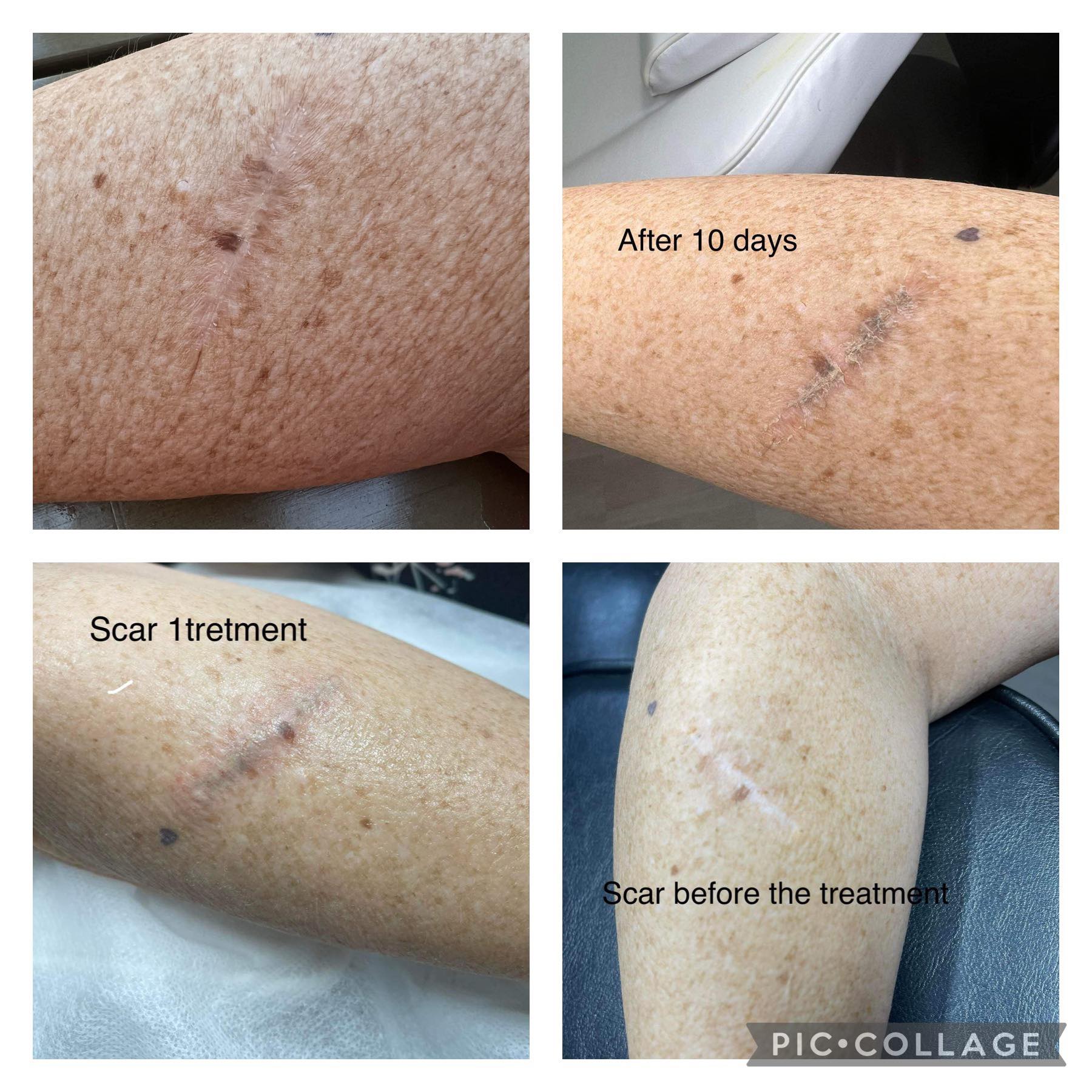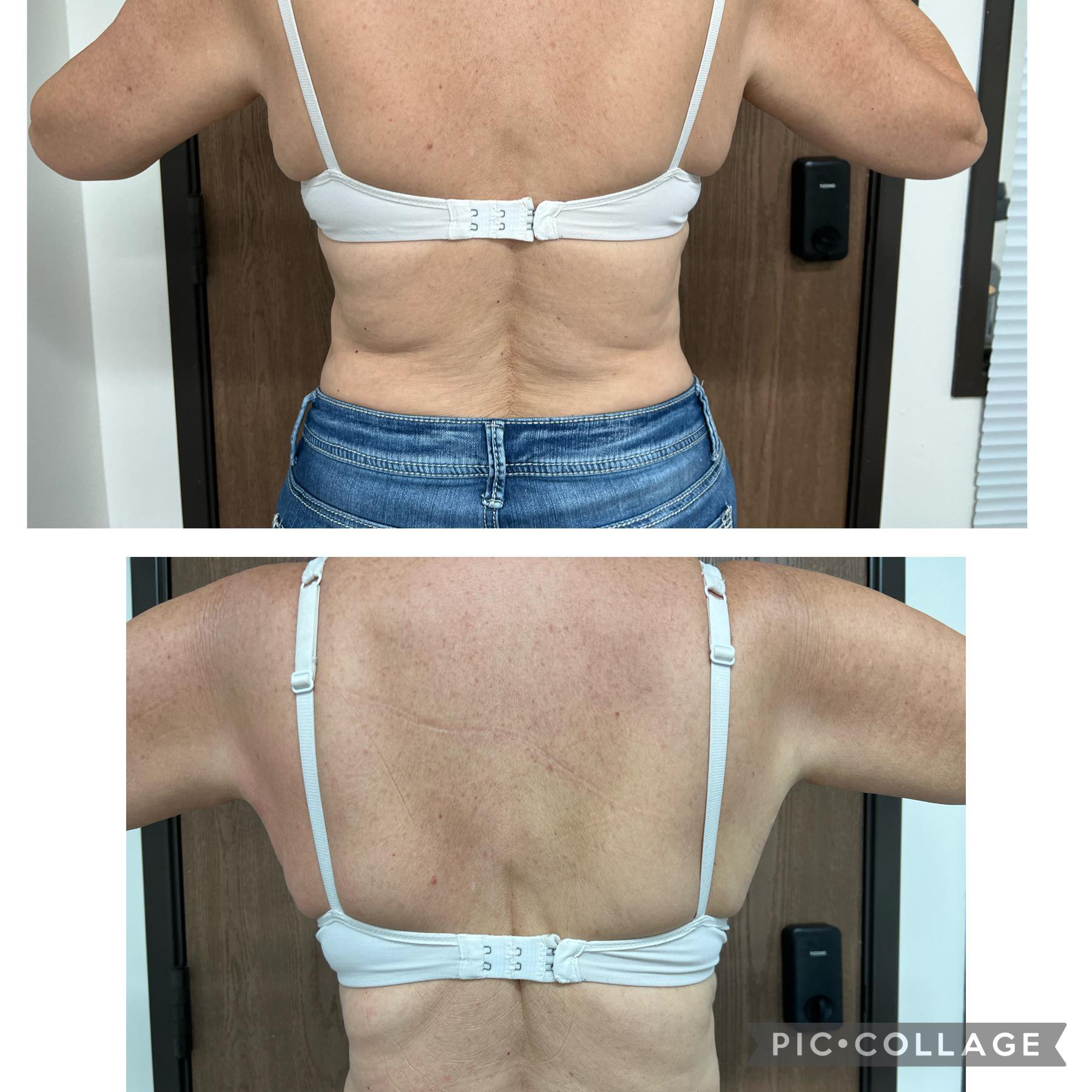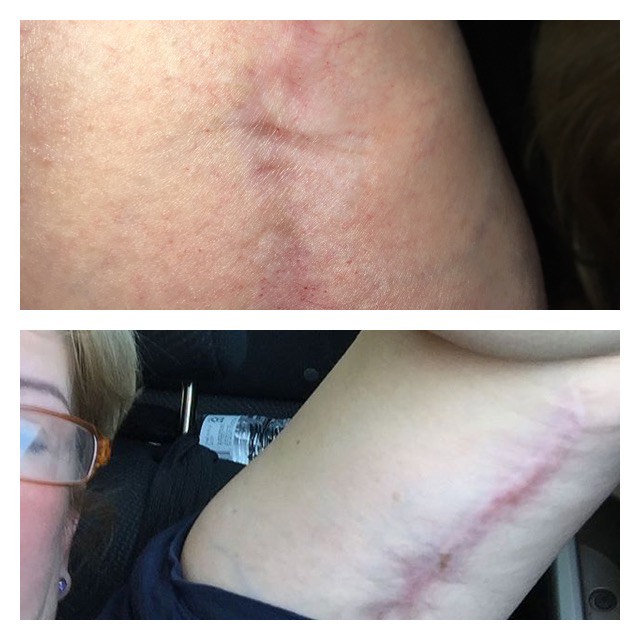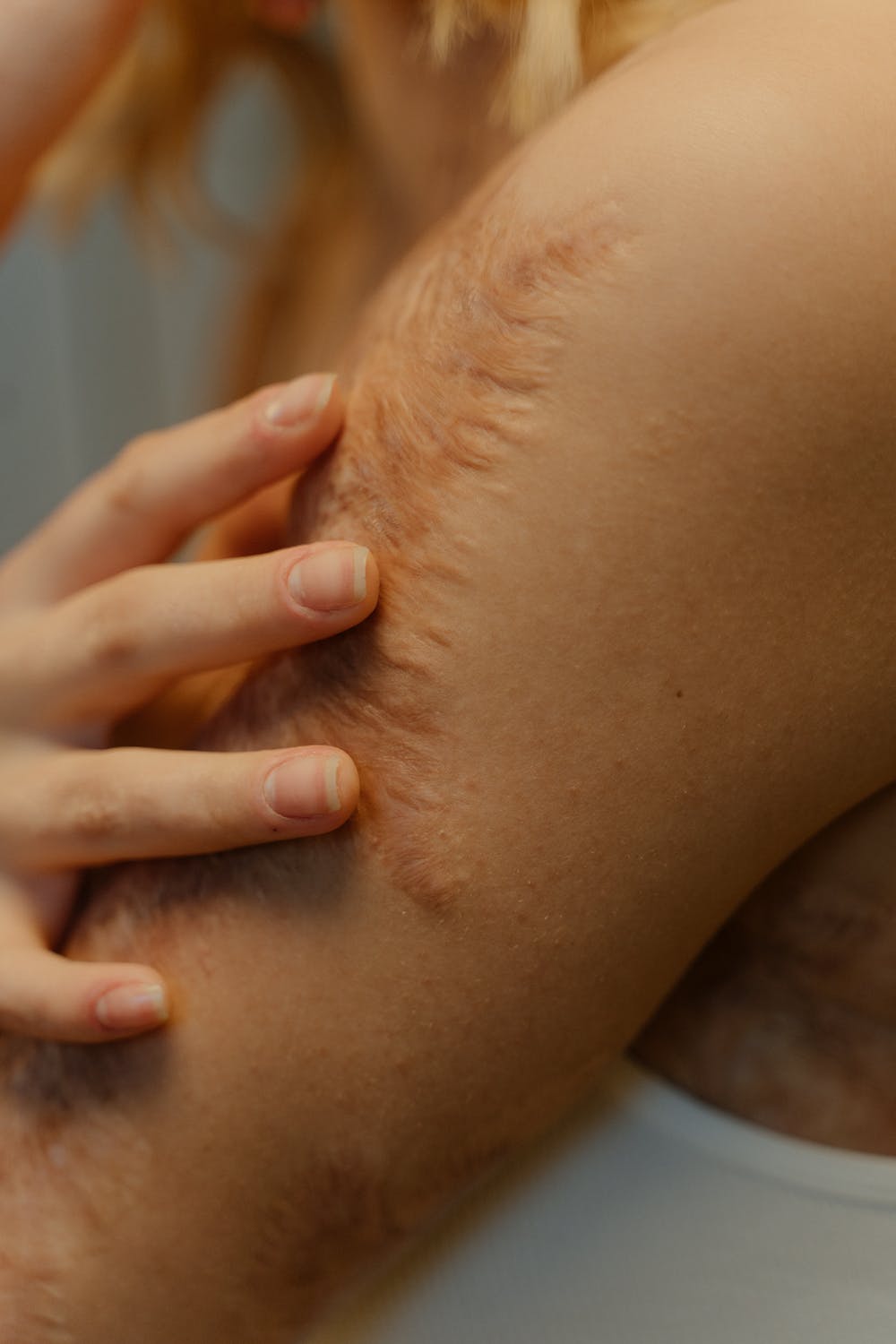Scar Camoflauge (Ink & Inkless)
Scar camouflage, whether using ink or inkless methods, is a specialized cosmetic procedure designed to minimize the appearance of scars on the skin. It involves the application of pigments or inkless solutions to the scarred area, matching the surrounding skin tone and texture to create a more uniform and natural-looking result.
Paramedical tattooing is the art of tattooing the skin with flesh tone pigments. The purpose of skin camouflage tattooing is to disguise a scar or a mispigmented skin area. Camouflage tattoos can help restore a person’s physical integrity and even help with psychological recovery after traumatic events.
Learn More About Scar Camoflauge
Ink Method: In the ink method of scar camouflage, a trained technician uses a tattoo machine with specialized needles to deposit pigments into the scar tissue. The pigments are carefully selected to match the client’s natural skin color, ensuring a seamless blend with the surrounding skin. The tattoo machine creates controlled punctures in the scarred area, allowing the pigments to be absorbed and effectively camouflaging the scar.
Inkless Method: The inkless method of scar camouflage involves using specialized serums or solutions that mimic the appearance of tattoo ink but do not contain actual pigments. These solutions are applied topically to the scarred area, layer by layer, to gradually build up coverage and blend the scar with the surrounding skin. The technician selects and blends the serums to match the client’s skin tone, achieving a natural and harmonious result.
Both methods aim to reduce the visibility of scars and create a more even skin tone and texture. The choice between ink and inkless methods depends on individual preferences, the nature of the scar, and the expertise of the technician performing the procedure.
It’s important to note that scar camouflage does not eliminate scars entirely. Instead, it helps minimize their appearance, making them less noticeable and creating a more uniform skin surface. The effectiveness of scar camouflage can vary depending on factors such as the type and severity of the scar, the color and texture of the surrounding skin, and individual healing responses.
Before considering scar camouflage, it’s recommended to consult with a qualified professional specializing in scar camouflage techniques. They can assess your specific situation, explain the procedure in detail, and provide personalized advice based on your needs and expectations.
Scar Camoflauge Procedure Details
The procedure details for scar camouflage, whether using ink or inkless methods, can vary depending on the specific techniques and products used by the technician. Here is a general overview of the procedure:
Consultation:
The process typically begins with a consultation with a trained professional specializing in scar camouflage. During the consultation, you can discuss your concerns, goals, and expectations for the procedure. The technician will assess your scar, its characteristics, and the surrounding skin to determine the best approach and discuss the potential outcomes.
Color Matching:
The technician will carefully analyze your natural skin tone and the pigmentation of the surrounding skin to create a custom color blend. This step ensures that the pigments or inkless solutions used in the procedure closely match your skin color, allowing for a seamless blend with the scar and surrounding skin.
Preparation:
Before the procedure, the technician will clean and prepare the scarred area. They may apply a numbing cream to minimize any potential discomfort or pain during the procedure.
Application:
For the ink method, the technician will use a tattoo machine with specialized needles to deposit pigments into the scar tissue. They will work meticulously, layering the pigments to gradually blend and camouflage the scar. The depth and intensity of the pigments may vary depending on the individual’s needs and desired coverage.
For the inkless method, the technician will apply specialized serums or solutions to the scarred area using techniques such as stippling or feathering. Multiple layers may be applied to build up coverage and achieve a natural-looking result.
Post-Procedure Care:
After the procedure, the technician will provide specific aftercare instructions. These instructions may include keeping the treated area clean, avoiding excessive exposure to water, sunlight, and harsh chemicals, and applying any recommended ointments or creams to aid in the healing process. It’s crucial to follow these instructions carefully to ensure proper healing and the best possible results.
Follow-up Sessions:
Depending on the severity of the scar and the desired outcome, multiple sessions may be required to achieve the desired level of coverage and blending. The technician will discuss the recommended number of sessions during the initial consultation and monitor your progress throughout the process.
It’s important to note that the exact details of the procedure can vary between technicians and clinics. It’s crucial to choose a reputable and experienced professional who specializes in scar camouflage and can provide personalized guidance based on your specific needs and goals.
Scar Camoflauge Before/Aftercare
Proper before and aftercare is essential to ensure the best possible results and promote the healing process after undergoing scar camouflage (ink or inkless method) procedures. Here are some general guidelines for before and aftercare:
Beforecare Instructions:
1. Consultation: Schedule a consultation with a qualified professional specializing in scar camouflage. During the consultation, discuss your medical history, scar condition, and any concerns or expectations you have for the procedure.
2. Avoid Sun Exposure: Minimize sun exposure to the treatment area for at least two weeks before the procedure. Sunburned or tanned skin can affect the color matching process and the overall outcome of the camouflage.
3. Avoid Tanning Products: Refrain from using self-tanning or spray-tanning products on the treatment area before the procedure. These products can alter the color of the skin and make it challenging to achieve accurate color matching.
4. Hydrate the Skin: Keep the skin well-moisturized in the days leading up to the procedure. This helps maintain the skin’s elasticity and overall health, which can contribute to better results.
5. Avoid Blood-Thinning Medications: If possible, avoid taking blood-thinning medications or supplements for a week prior to the procedure. These can increase the risk of bleeding and affect the healing process.
6. Patch Test: Some professionals may require a patch test before the procedure to check for any adverse reactions or allergies to the pigments or inkless solutions used.
Aftercare Instructions:
1. Keep the Area Clean: Gently clean the treated area with a mild, fragrance-free cleanser and lukewarm water. Avoid harsh rubbing or scrubbing, and pat the area dry with a clean towel.
2. Avoid Moisturizers or Ointments: Refrain from applying any moisturizers, lotions, or ointments to the treated area for the first few days. This allows the pigments or inkless solutions to settle properly.
3. Avoid Sun Exposure: Protect the treated area from direct sunlight and UV rays for at least two weeks. Sun exposure can fade the pigments or alter the color matching, leading to less desirable results.
4. Avoid Swimming and Hot Baths: Steer clear of swimming pools, hot tubs, and saunas for at least two weeks. Excessive moisture and heat can interfere with the healing process.
5. Don’t Scratch or Pick: Avoid scratching, picking, or rubbing the treated area, as this can disrupt the healing process and affect the final outcome.
6. Follow Post-Procedure Care Instructions: Your technician will provide specific post-procedure care instructions tailored to your individual needs. Follow these instructions diligently to ensure optimal healing and long-lasting results.
7. Attend Follow-Up Sessions: Depending on the desired level of coverage and blending, you may need multiple sessions. Attend all scheduled follow-up appointments to allow the technician to assess the progress and make any necessary adjustments.
It’s important to note that individual experiences and healing times may vary. Always consult with a qualified professional for personalized before and aftercare instructions based on your unique situation and the specific procedure you undergo.
Benefits of Scar Camouflage
(Ink or Inkless Method)
Scar camouflage, whether using the ink or inkless method, offers several benefits for individuals seeking to minimize the appearance of scars. Here are some key benefits:
1. Improved Appearance: The primary benefit of scar camouflage is the improvement in the appearance of scars. By using pigments or inkless solutions that match the surrounding skin tone, the procedure helps to blend the scar with the natural skin color, making it less noticeable. This can significantly boost self-confidence and improve overall satisfaction with one’s appearance.
2. Enhanced Self-esteem: Scars, especially those in prominent areas, can often affect a person’s self-esteem and body image. Scar camouflage provides an opportunity to diminish the visibility of scars, allowing individuals to feel more comfortable and confident in their own skin.
3. Versatility: Scar camouflage can be applied to various types of scars, including surgical scars, acne scars, burn scars, and injury scars. It is a versatile procedure that can be customized to address different scar types, sizes, and locations.
4. Customized Results: Skilled technicians can tailor the scar camouflage procedure to each individual’s needs. They can carefully match the pigments or inkless solutions to the client’s skin tone, ensuring a seamless blend and natural-looking results. The procedure can be adjusted to achieve the desired level of coverage and blending.
5. Long-lasting Effects: Scar camouflage is a semi-permanent solution, meaning that the results can last for an extended period. While the pigments may fade over time, the effects of scar camouflage can be long-lasting. This can provide individuals with prolonged satisfaction and relief from the visibility of their scars.
6. Non-invasive: Scar camouflage is a non-invasive procedure, meaning it does not involve surgical incisions or invasive techniques. It offers a non-surgical alternative for scar improvement, making it a suitable choice for individuals who prefer to avoid more invasive procedures.
7. Minimal Downtime: Recovery time after scar camouflage is generally minimal. While there may be some temporary redness or sensitivity in the treated area, most individuals can resume their daily activities shortly after the procedure. This makes scar camouflage a convenient option for those with busy schedules.
It’s important to consult with a qualified professional who specializes in scar camouflage to discuss your specific needs and expectations. They can assess your scars, explain the potential benefits, and provide personalized advice on the suitability of scar camouflage for your particular situation.





